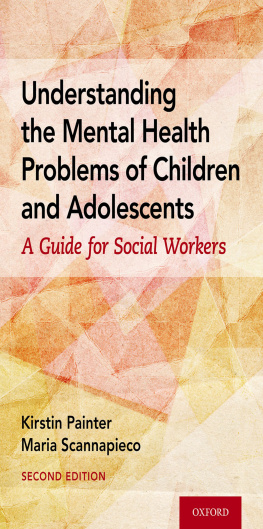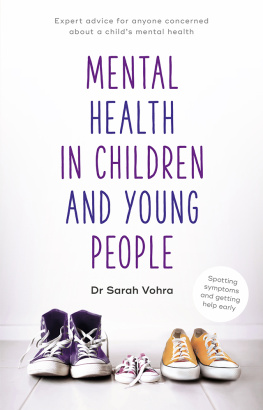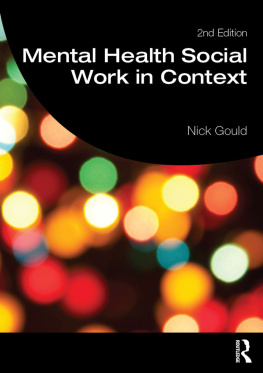Understanding the Mental Health Problems of Children and Adolescents

Oxford University Press is a department of the University of Oxford. It furthers the Universitys objective of excellence in research, scholarship, and education by publishing worldwide. Oxford is a registered trade mark of Oxford University Press in the UK and certain other countries.
Published in the United States of America by Oxford University Press
198 Madison Avenue, New York, NY 10016, United States of America.
Oxford University Press 2021
First Edition published in 2015 by Lyceum Books, Inc.
Second Edition published in 2021
All rights reserved. No part of this publication may be reproduced, stored in a retrieval system, or transmitted, in any form or by any means, without the prior permission in writing of Oxford University Press, or as expressly permitted by law, by license, or under terms agreed with the appropriate reproduction rights organization. Inquiries concerning reproduction outside the scope of the above should be sent to the Rights Department, Oxford University Press, at the address above.
You must not circulate this work in any other form and you must impose this same condition on any acquirer.
Library of Congress Cataloging-in-Publication Data
Names: Painter, Kirstin, 1963 author. | Scannapieco, Maria, author.
Title: Understanding the mental health problems of children and adolescents :
a guide for social workers / Kirstin Painter and Maria Scannapieco.
Description: Second edition. | New York, NY : Oxford University Press,
2021. | Includes bibliographical references and index.
Identifiers: LCCN 2020037506 (print) | LCCN 2020037507 (ebook) |
ISBN 9780190927844 (paperback) | ISBN 9780190927868 (epub) |
ISBN 9780197554548 (oso)
Subjects: LCSH: Child mental health. | TeenagersMental health.
Classification: LCC RJ503 .P35 2021 (print) | LCC RJ503 (ebook) |
DDC 618.92/89dc23
LC record available at https://lccn.loc.gov/2020037506
LC ebook record available at https://lccn.loc.gov/2020037507
DOI: 10.1093/oso/9780190927844.001.0001
Dr. Painter completed this work while she was a Program Specialist at the National Institute on Disability, Independent Living, and Rehabilitation Research.
Contents
List of Figure
List of Tables
List of Boxes
Stumbling through the dense forest, the roots of giant trees continually tripped me. One day I tripped on yet another root, but this time I looked up to find the right tree.
This is what it feels like to have a child with mental health problems. If your child has asthma, diabetes, or other illnesses, you can ask around and find resources, physicians, and treatments. But even in the second decade of the 21st century, mental illnesses remain in dark shadowsseldom mentioned in polite society. Yet one in five children at any given time is experiencing some form of mental illness. Mental illnesses must come out of the shadows, but they have a long way to go.
Imagine, if you will, what it must be like to have a child who is violent, using street drugs, sexually active, or out of control. Because the symptoms of mental illnesses are typically behavioral, parents have a tendency to blame themselves for not teaching their children well. And others blame the parents as well. How often have you heard, If her parents just spent more time with her, If his parents didnt let him get away with everything, If her parents were more involved, they would know where she is and who she is with.
As a parent of a child who was diagnosed with bipolar disorder as an adolescent, I can tell you these remarks sting. Perhaps even more stinging, though, is that you used to say the same things about children and adolescents who seemed out of control. What is wrong with the parents? Cant they control that child?
In the following pages, Dr. Kris Painter and Dr. Maria Scannapieco will present an excellent discussion on mental illnesses in children and adolescents. They have kindly asked me to write a Foreword to give you the perspective of a parents experiences when a child or adolescent has a mental illnessand ways you can help.
The first thing a social worker can do is avoid guilt-inducing statements, gestures, or eye-rolling when determining a childs background. Yes, the parents might have been responsible in part for triggering their childs symptoms. However, what good does it do to add guilt on top of the guilt? If parents are seeking help for their children, they cant be all bad, can they? Instead, the therapist can help parents discover their strengths and help them make a better future for themselves and their children.
Second, social workers need to recognize that parents go through all the stages of grief when learning that their child has a mental illness. What would your reaction be if the child you held in your arms as an infantthe child whose future you dreamedwas diagnosed with a lifelong illness that could prevent those dreams from coming true? In the earliest stages, parents are often in denial, no matter how educated or accepting they are of mental illnesses. They do not want this for their children. Social workers can play a role in helping parents recognize and navigate their grief as they work to help their children recover.
It is also common for social workers to become frustrated with parents who will not ensure that their children take prescribed medication. Again, though, put yourself in their place. They have read about children committing suicide after starting antidepressants. The news is big and bold on the front page. Unfortunately, explanations and medical discussions of these issues are buriedif they are included in the news at all. So parents do not always have a wealth of resource information. And they do not turn to their friends because no one ever talks about mental illness, so they feel they must be the only ones grappling with this problem.
It is always important to listen to the parents just as intently as you do the child or adolescent. The children with mental illnesses whom I have encountered are often among the brightest I have ever known. As such, they know what to say to make themselves look good and their parents look bad. In one case, a therapist in a residential treatment center was shocked when my daughter had a full meltdown during family therapy 2 months into her treatment. Her comment was an incredulous, Ive never seen this child before. My response was, This is the child I live with every day. While there were certain satisfactions in having the therapist see what I had been saying, there was still the wasted 2 months when the behaviors were not addressed because my daughter had never displayed themin spite of my discussing them.
Another role the social worker can play is mediator/facilitator. Too many therapists see the parentchild relationship as antagonistic. It may appear this way because many parents have no way to understand what has been happening. They have been struggling with discipline and may be at their wits end. There are even some parents who communicate their frustrations to their children, using phrases such as, Ive had enough. I give up. The situation may seem antagonistic, and sometimes it is. Often, though, the parents have no idea how to work with an emotionally disturbed child. They blame themselves, but they keep struggling. And, all too often, social workers present an air of mystery and intrigue. Thank you for bringing your child to me. Now you just sit out here in the waiting room while we talk. The parent is left totally in the dark, unaware of what is being discussed ormore importantlywhat he or she can do to help. The social worker could bring the parent into the room with the child in the last few minutes of the session. This might be a good time to encourage the child to communicate feelings and to discuss the illness openly with the parent and child together. The more parents can be on the same page with the therapist and the child, the more effective the changes at home can be. After all, parents who have been raised a certain way can find it difficult to suddenly change their parenting styles. But if they understand the benefit to their child, they may feel more empowered to make those changes.








